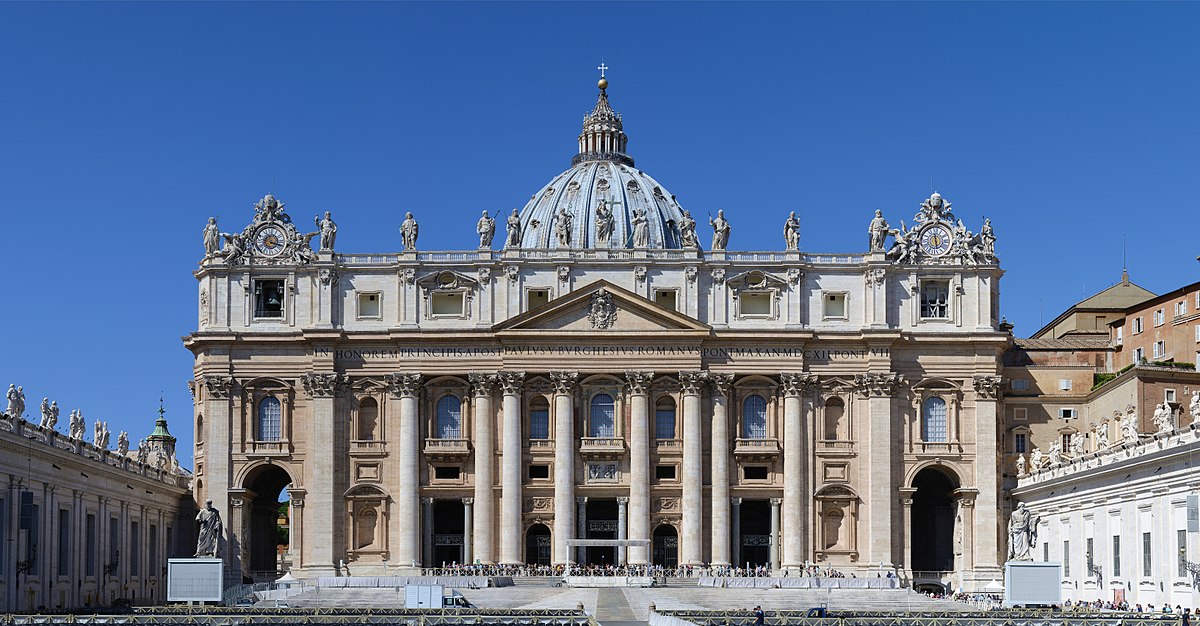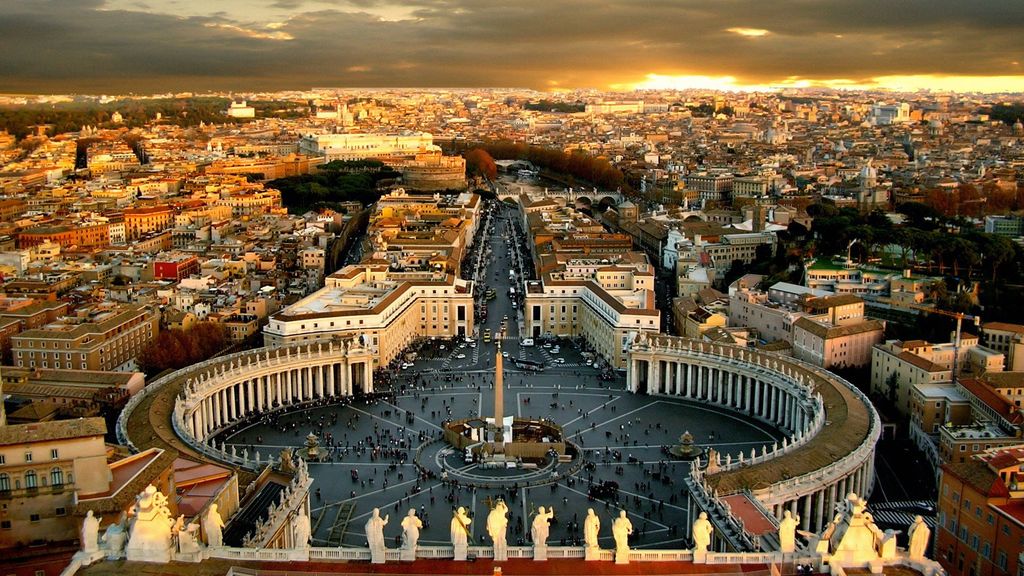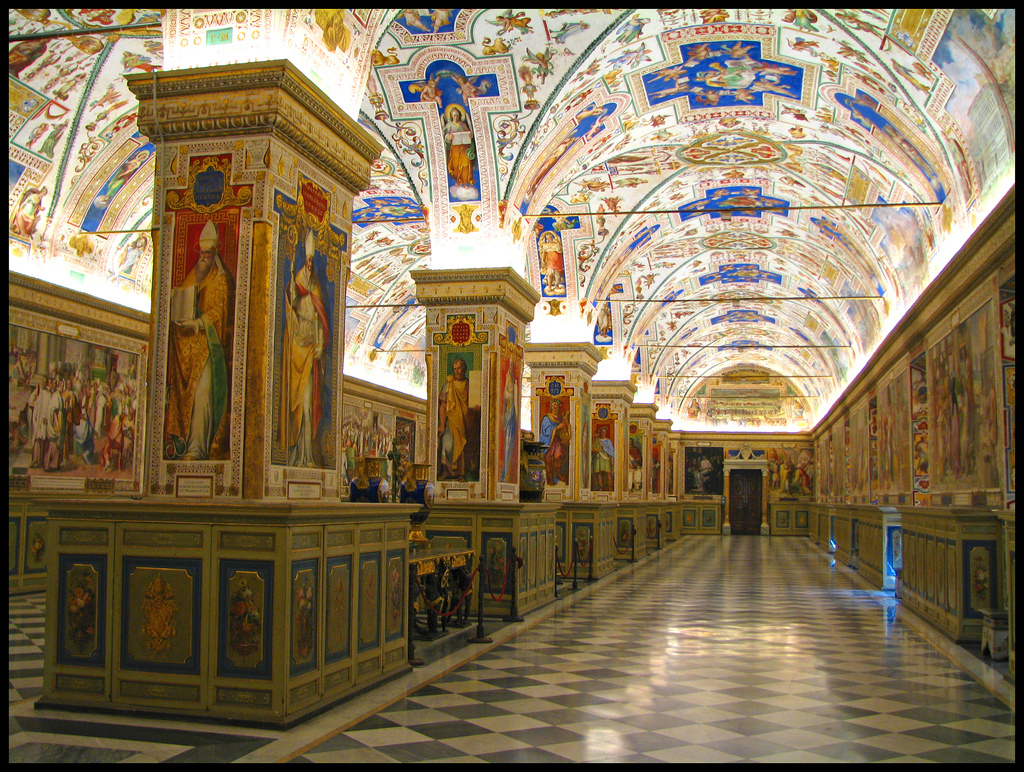St. Peter’s Basilica
The centerpiece of the Vatican, the magnificent St. Peter’s Basilica was built between the 16th and 18th centuries, replacing earlier structures that began in 326 on what is thought to be where St. Peter was buried. Ironically, it was the selling of indulgences to finance this building in the 16th century that provoked Martin Luther to begin the Protestant Reformation. The work of famous artists begins before you enter the church: in the portico are an equestrian statue of Constantine by Bernini and fragments of a mosaic by Giotto above the main doorway. It’s from the old church, as are the double bronze doors.
The huge nave – 185 meters long and 46 meters tall – rises to a dome 119 meters above and can accommodate a congregation of more than 60,000. Compare it to the dimensions of other great churches marked in the floor. On your right, Michelangelo’s famous Pietà, sculpted when he was only 24, is behind reinforced glass. Also on the right is the richly decorated Chapel of the Sacrament, with Bernini’s tabernacle and his rival Borromini’s bronze grille.
Michelangelo’s dome is held on four massive pentagonal piers, and below it, under Bernini’s magnificent Baroque bronze baldacchino (canopy), is the Papal altar. Below is the tomb of St. Peter. The bronze throne in the apse, flanked by papal tombs, is also by Bernini. Tombs of more Popes are in the right aisle. Near the Baptistery are the stairs (a lift is outside near the Gregorian Chapel) to the roof, from which you can climb 330 steep steps inside the dome to the lantern for a closer look at the dome’s structure and magnificent views over St. Peter’s Square. Below the church is the crypt, with more papal tombs and an excavated cemetery, which about 250 people a day can visit on a guided tour.

Sistine Chapel
Built by Pope Sixtus IV in 1473-84, the Sistine Chapel is a rectangular hall that is the Pope’s domestic chapel, also used for services and special occasions. After the death of a Pope, the conclave to elect his successor is held here. The frescoes by Michelangelo and others covering the walls and ceiling, acknowledged as the pinnacle of Renaissance painting, were extensively restored from 1980 to 1994, removing layers of candle-soot, dust, varnish, grease, and overpainting to reveal their original luminous colors.
The side walls are covered with large frescoes of Biblical scenes against the background of Umbrian and Tuscan scenery, painted for Sixtus IV by the most celebrated painters of the day – Perugino, Botticelli, Rosselli, Pinturicchio, Signorelli, and Ghirlandaio. These late-15th-century paintings already reflect the ideas of humanism, recognizing humans as individuals and important in the historical process. The left-hand wall shows Old Testament scenes, the right wall New Testament scenes.
The frescoes on the ceiling were painted by Michelangelo, almost completely unaided by assistants, in the reign of Pope Julius II, between 1508 and 1512. Michelangelo’s ambitious idea was to depict the Creation as described in Genesis, beginning with God separating light from darkness, creating the sun and the moon, separating land and sea, and creating Adam and then Eve, and continuing through the story of Noah. Below in the vaulting are colossal figures of the prophets and sibyls. Michelangelo began work on the large fresco on the altar wall in 1534, depicting the final scene in the story of the world, the Last Judgment. Its dramatic presentation and artistic finesse rank it as one of the greatest achievements of European painting.

Vatican Library
The value of its contents makes the Vatican Library the richest in the world, with 7,000 incunabula (printed before 1501), 25,000 medieval hand-written books, and 80,000 manuscripts that have been collected since the library’s founding in 1450. And that’s just the old books; it doesn’t count all the books it contains that were printed since the end of the 15th century. In its 70-meter-long hall, built by Domenico Fontana, you can admire some of its most precious treasures – beautiful hand-illuminated Gospels, Biblical codices, early printed books, parchment manuscripts, and ancient scrolls and papyri. The library also has a recently expanded collection of pontifical coins and medals.

